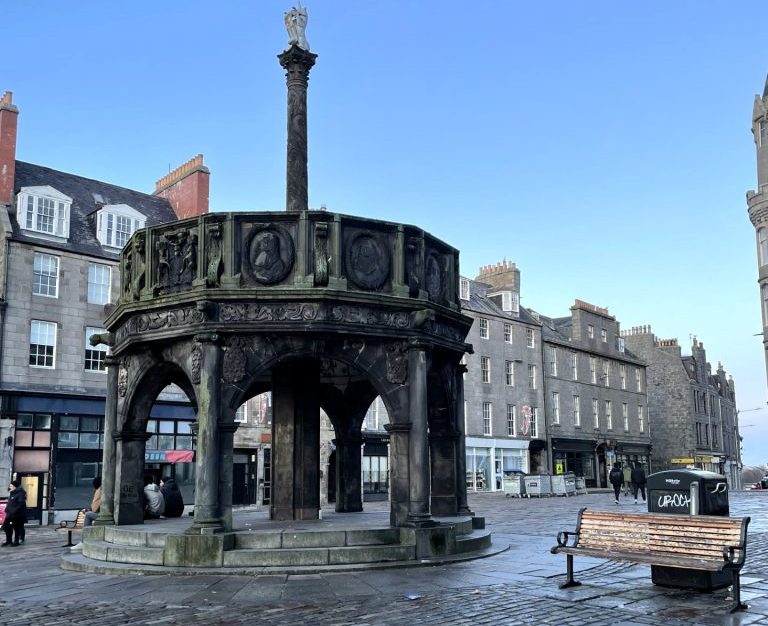The Mercat Cross was an important commercial area in Northeast Scotland. It is located in Castlegate, one of the oldest areas of Aberdeen.
It dates back to 1686 and was designed and manufactured by local architect John Montgomery. It initially served as a meeting place for merchants, then it became a site for executions and proclamations. James Stuart, the Old Pretender, was declared king at the Mercat Cross during the Jacobite uprising of 1715.

It was rebuilt in 1821 and served as Aberdeen’s post office in 1822. At that time, the arches were sealed, and doors and windows were added. Over the years, it returned to its original structure.
Renaissance Hexagonal Structure
The open-arch and hexagonal-base structure is made of sandstone, measuring 6 meters in diameter and 5 meters in height. Its sides are ornamented with doubled Ionic columns at the angles, supporting an entablature and cornice.
The entablature above each of the faces is divided into two compartments. There are 12 in total, displaying the city’s arms, the royal arms of Scotland, and medallions of royal portraits, from James I of Scotland to James VII of England.
Royal Emblem of the Scottish Monarchies
Unlike the Mercat Crosses of other trading towns and cities in Scotland, Aberdeen’s market is not marked by a cross. At its center, a Corinthian capital rises, supporting a unicorn with a gilded horn, the royal emblem of the Scottish monarchies.
During the repair carried out in 1821, it was discovered that the unicorn crowning the central column is made of pure white estuary marble, not sandstone like the rest of the structure. In 1990, the shaft and the unicorn were replaced. The originals are displayed in the Tolbooth Museum.
Traditional Heart of the Burgh
Aberdeen once had two crosses. There was the Fish Cross at the eastern end of Castlegate, where fishermen displayed their merchandise. Also, the Meat Cross at the western end of the market square, where meat was sold on permitted days. The Mercat Cross replaced the Meat Cross in 1686, while the Fish Cross was removed in 1742.
The traditional heart of the burgh was dismantled and rebuilt in 1842 at a site further east. The city superintendence ordered the move, carefully preserving the original structure.
Among the changes made, the brickwork between the support columns was removed, and the lower part was opened. The masonry that filled the arches of the Cross was not restored, making the Aberdeen Mercat Cross even more exceptional among others in Scotland.
Today, the monument remains an important landmark in the city’s daily life, serving as a meeting place and focal point for public events and festivities. It is a popular tourist attraction in Aberdeen, where visitors can admire its historical architecture and learn about its cultural significance.
In summary, the Mercat Cross of Aberdeen is much more than just a monument; it is a symbol of the city’s identity and heritage, continuing to inspire and captivate residents and visitors alike.

